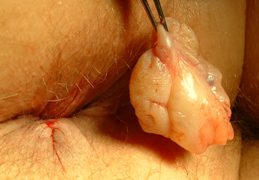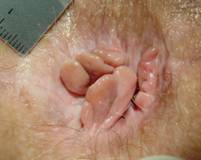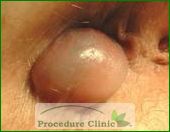Hemorrhoids Online Registration
For the complete information on hemorrhoids, please go to the website hemorrhoidheal.com.
Internal Hemorrhoids
 There are three types of hemorrhoids – internal, external, and mixed. Internal hemorrhoids form above the dentate line, while external hemorrhoids form below the dentate line. Mixed hemorrhoids can either refer to lesions formed at the dentate line, or to the presence of both internal and external hemorrhoids.
There are three types of hemorrhoids – internal, external, and mixed. Internal hemorrhoids form above the dentate line, while external hemorrhoids form below the dentate line. Mixed hemorrhoids can either refer to lesions formed at the dentate line, or to the presence of both internal and external hemorrhoids.
External hemorrhoids are those occur outside the anal verge. External hemorrhoids usually affect the cleansing after the bowel movement and cause the skin irritation and itching. The thrombosed external hemorrhoids occur if the varicose veins rupture and the blood clots develop, it is often accompanied by swelling and irritation.
Internal hemorrhoids are graded from I to IV based on the degree of prolapse.
- Grade I: No prolapse. Just prominent blood vessels.
- Grade II: Prolapse upon bearing down (defecation) but spontaneously reduces.
- Grade III: Prolapse upon bearing down and requires manual reduction.
- Grade IV: Prolapsed and cannot be manually reduced.
Symptoms of Internal Hemorrhoids
 Anal itching is a common symptom of hemorrhoids, but initial relief of the itching does not necessarily mean the problem goes away. It comes and goes, and it gets worse when hemorrhoids flare up. Continuous scratching or excessive cleaning of the anal area may further harm the sensitive tissues and worsen the symptoms.
Anal itching is a common symptom of hemorrhoids, but initial relief of the itching does not necessarily mean the problem goes away. It comes and goes, and it gets worse when hemorrhoids flare up. Continuous scratching or excessive cleaning of the anal area may further harm the sensitive tissues and worsen the symptoms.
Although anal pain is a common sign of anorectal disease, internal hemorrhoids are usually not painful due to being located above the dentate line of the rectum. Hemorrhoid patients may have mild aching pain and discomfort when hemorrhoids flare up. The pain could be more severe when complications develop, such as thrombosis, infection and sphincter spasm (Proctalgia Fugax).
Hemorrhoids are probably the most common reason for having a rectal lump. It can be caused by internal hemorrhoids, but more commonly by external hemorrhoids. If a rectal lump is related to internal hemorrhoids, it usually gets bigger and more prolapsed right after the bowel movement; it could be spontaneously reduced in the early stage of internal hemorrhoids. But it could be non-reducible in the late stage of hemorrhoids. It may be associated with other symptoms such as bleeding, itch or pain. The thrombosed external hemorrhoids usually have very painful lump.
Rectal bleeding is the most common symptom of hemorrhoids. The severity of rectal bleeding varies widely. Besides hemorrhoids, many other conditions also cause rectal bleeding, including ruptured thrombosed external hemorrhoids, fissures, diverticulosis, colon cancer, colitis, polyps and angiodysplasias, however even the slightest amount of bleeding should be taken seriously.
Complications of Internal Hemorrhoids
 Anal Itching
Anal Itching
Anal itching, or pruritis, is one of the most common symptoms related to hemorrhoid disease in Minnesota. Anal itching is instigated by the anal skin inflammation triggered by the hemorrhoids. Excessive wiping and scratching further damage the perianal skin and causes chronic dermatitis. Over use of OTC hemorrhoid cream containing steroid can cause the damage in the perianal skin. The patients may develop the true complication called Pruritic Ani with persistent cyclic anal itching.
Thrombosed External hemorrhoid
Thrombosed external hemorrhoid occurs when the enlarged hemorrhoidal venous complex ruptures, a blood clot can then form in the hemorrhoid. Thrombosed hemorrhoids are usually quite painful, and it requires immediate surgical intervention to remove the blood clot.
Anemia
Chronic blood loss from hemorrhoids may cause anemia, resulting in fatigue and weakness. We had a few cases in Minnesota in the past few years that developed severe iron deficiency anemia due to hemorrhoidal bleeding, and their Hemoglobin dropped to as low as 5 or 6.
Strangulated hemorrhoid
When the hemorrhoids are so severe that they prolapse, it leads to the anal sphincter spasm due to pain and irritation. Persistent sphincter spasm can cut off blood supply to an internal hemorrhoid which causes more swelling of hemorrhoid tissue, it turns into a vicious cycle. Eventually, the hemorrhoid may be “strangulated,” which can cause extreme pain and lead to tissue death.
Infection
The local inflammation triggered by the bulging hemorrhoids causes the swelling and erosion of anorectal mucosa, which may increase the chance of infection. Opportunistic bacteria and microorganisms established on feces and the surrounding might attack and flourish in the damaged tissue.
Uncomplicated External Hemorrhoids
 Everyone has a normal hemorrhoidal tissue in their rectum and anus. It’s only when your hemorrhoidal veins enlarge and become varicose veins that they’re considered abnormal or diseased. Internal hemorrhoids form above the dentate line, while external hemorrhoids form below the dentate line. They are covered proximally by anoderm and distally by skin, both of which are sensitive to pain and temperature.
Everyone has a normal hemorrhoidal tissue in their rectum and anus. It’s only when your hemorrhoidal veins enlarge and become varicose veins that they’re considered abnormal or diseased. Internal hemorrhoids form above the dentate line, while external hemorrhoids form below the dentate line. They are covered proximally by anoderm and distally by skin, both of which are sensitive to pain and temperature.
External hemorrhoids usually affect the cleansing after the bowel movement and cause the skin irritation and itching. The patients may feel the lumps near or around the anus.
 Small and asymptomatic external hemorrhoids don’t need any treatment, however most patients will have an intermittent flare up. Eventually patients may need surgery (external hemorrhoidectomy) if you have large external hemorrhoids and/or persistent symptomatic external hemorrhoids.
Small and asymptomatic external hemorrhoids don’t need any treatment, however most patients will have an intermittent flare up. Eventually patients may need surgery (external hemorrhoidectomy) if you have large external hemorrhoids and/or persistent symptomatic external hemorrhoids.
Anal Tags
Anal skin tags are flaps of skin or flesh found around the anus. The tags are usually flesh colored and hang in the opening of the anus by a stalk or stem that supplies the blood to the tag. Anal skin tags are usually associated with hemorrhoids or other anorectal problems.
Causes of anal tags include:
 Anal tags can easily be removed in our office using local anesthetic and a radiofrequency device. The procedure only takes less than 10 minutes and you are able to drive yourself home afterwards.
Anal tags can easily be removed in our office using local anesthetic and a radiofrequency device. The procedure only takes less than 10 minutes and you are able to drive yourself home afterwards.
External Thrombosed hemorrhoids
External hemorrhoids develop below the dentate line and outside the anal verge. Thrombosed external hemorrhoids occur if varicose veins rupture and blood clots develop. It is often accompanied by swelling with a bluish-purplish discoloration and severe pain.
 The treatments for external hemorrhoids are different from those for internal hemorrhoids. One treatment option is to allow clots in the external hemorrhoids to be slowly absorbed by the body over several weeks. The symptoms may improve in some patients with conservative nonsurgical treatment – the anal care we coined includes stool softeners, increased dietary fiber, increased fluid intake, warm Sitz baths, and analgesia. For most patients, surgical excision is often more effective and efficient in treating thrombosed external hemorrhoids.
The treatments for external hemorrhoids are different from those for internal hemorrhoids. One treatment option is to allow clots in the external hemorrhoids to be slowly absorbed by the body over several weeks. The symptoms may improve in some patients with conservative nonsurgical treatment – the anal care we coined includes stool softeners, increased dietary fiber, increased fluid intake, warm Sitz baths, and analgesia. For most patients, surgical excision is often more effective and efficient in treating thrombosed external hemorrhoids.



